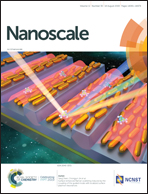A flexible bimodal sensor based on an electrospun nanofibrous structure for simultaneous pressure–temperature detection†
Abstract
We developed a flexible and multifunctional resistive sensor integrating uniform conductive coating layers with an interlaced nanofibrous structure through a large-scale and cost-efficient strategy. The elastomer nanofiber framework not only endows the multi-mode sensor with superior flexibility, but also provides abundant contact sites and contact areas, which can significantly enhance the sensitivity and operating range of the obtained sensor. More impressively, the multilevel sensing paths comprising both interlaminar and intrastratal signal transmissions fulfill the simultaneous and precise detection of pressure–temperature stimuli without interference with each other. The obtained sensor ultimately shows an ultrahigh pressure sensitivity of 1185.8 kPa−1 and superior reliability, enabling the rapid detection of a subtle stimulus as low as 2.4 Pa and superior response behavior under 5000 cyclic loading tests. Besides, high linearity and stability are achieved for the temperature sensing characteristic even under various pressure loadings. These outstanding performances are further evaluated by preparing a 4 × 5 bimodal sensor array to synchronously monitor multiple signals, consequently demonstrating precise sensing capability with negligible interference and providing an effective approach for developing multiparametric sensing platforms and wearable devices.



 Please wait while we load your content...
Please wait while we load your content...